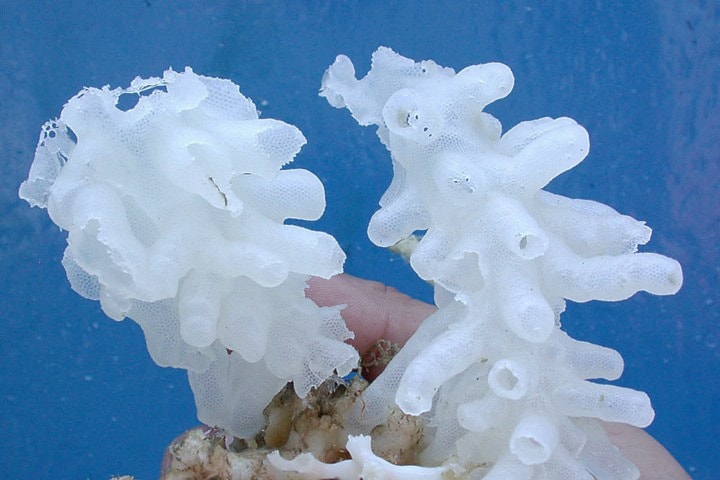A 9,000-year-old glass sponge reef ecosystem in the North Coast was recently announced as a protected area by the federal government.
The area, known as the Hecate Strait and Queen Charlotte Sound Glass Sponge Reefs Marine Protected Area (MPA), covers 2,410 km-squared.
The aquatic territory represents ocean along the Pacific North Coast, southeast of Haida Gwaii and between the northern and southern entrance to Douglas Channel.
Among the many marine benefits the (once thought extinct) reefs from the Jurassic Period provide water filtration, as well as serving as refuge, habitat and nursery grounds for aquatic species, including rockfish, finfish and shellfish species, as detailed by Fisheries and Oceans Canada in a press release.
The largest sponge reef in Hecate Strait (four total in the area), covers an area 35km long by 15km wide and 25 metres tall. A reef found in Chatham Sound is 12km long and three km wide. The reef structures are extremely fragile and take up to several hundred years to recover from damage.
The area is intended to be just one part of a growing network of MPAs throughout Canada to serve as a globally unique conservation target, and part of the federal government’s commitment to protect five per cent of marine and coastal areas by the end of 2017.
The reefs were partly brought to the forefront by research conducted by Spectra Energy for its Westcoast Connector Gas Transmission Project. As well, Canadian Parks and Wilderness Society has been seeking protection for the reefs for years.
The David Suzuki Foundation applauded the announcement.
“The sponge reefs, that cover roughly the same area as the Lower Mainland, are globally unique and their contribution to overall ocean health and fisheries is only beginning to be understood. This MPA not only safeguards the sponge reefs but also fisheries that are inextricably linked to a healthy ecosystem,” said foundation senior research scientist Scott Wallace.
The conservation measure effectively bans some human activities, such as commercial fishing, which has prompted the Canadian Independent Fish Harvesters’ Federation to speak against the measure that prevents groundfish trawling, longlining or any kind of fishing in an area that is rich with crab, prawn, shrimp, hake and halibut.
“We totally support protecting the glass sponge reefs and have for years but Department of Fisheries and Oceans has completely ignored our advice after seven years of consultation. A sustainable fishery and good jobs can easily co-exist with an MPA that continues to allow fishing in this very important part of the B.C. coast,” said Jim McIsaac, vice-president of the Canadian Independent Fish Harvesters’ Federation Pacific.
DFO Media Relations’ Carole Saindon said that the measures have been put in place based on peer-reviewed science and public input for a multi-zoned approach.
“The Core Protection Zone (CPZ) contains the sponge reefs, seabed and subsoil as well as the water column from the seabed to a minimum of 40 metres from the highest point of each reef,” she said, describing a tri-zoning approach.
“In order to protect the sponge reefs, additional fisheries management measures within the MPA boundary prohibit the use of mobile bottom-contacting fishing gear in the adaptive management zones,” Saindon stated.
Minister of Fisheries, Oceans and the Canadian Coast Guard Dominic LeBlanc noted that many interested parties, including Aboriginal groups were involved in the new designation.
“These ancient reefs highlight the importance of preserving the globally unique and ecologically important treasure in our Canadian oceans,” LeBlanc said.
Prince Rupert impact
North Coast fishermen Glen Kierce and Peter Haugan reacted to the news last week.
Kierce, who runs Deep Sea Charters, said that fishermen are used to closures such as the Glass Sponge Reef MPA, but the ban may extend to places it need not to.
“Everybody’s always concerned when they start implementing closures like this and it affects where a person can fish,” Kierce said.
“There’s a wide spread of [different fishing methods]. Like some guys – a small percentage are trawling and some are longliners. I don’t know the percentage, but there’s all different user groups that would hit those areas ... I encourage the protection of the sponge reefs, but like I say, do they need to go that wide on the closure area? You could probably downsize it a bit, right?” Kierce said.
Haugan added that he isn’t so much affected but he’s concerned for the potential money lost by his colleagues on the water.
“[A ban] doesn’t affect me but it sure affects my fellow fishermen. They have been trawling Hecate Strait for 100 years and there’s more fish than they’ve ever had and now we’ve got no boats anymore and we’re on quota,” Haugan said.
“I don’t see the rationale behind this because the boats don’t go and fish in the sponge reefs, because that’s not where they’re going to get their fish. The nets aren’t going to be clean fishing in an area like that. I don’t know, I just think if you can stop everything you might as well stop us riding down the road. We might kill a beetle.”
